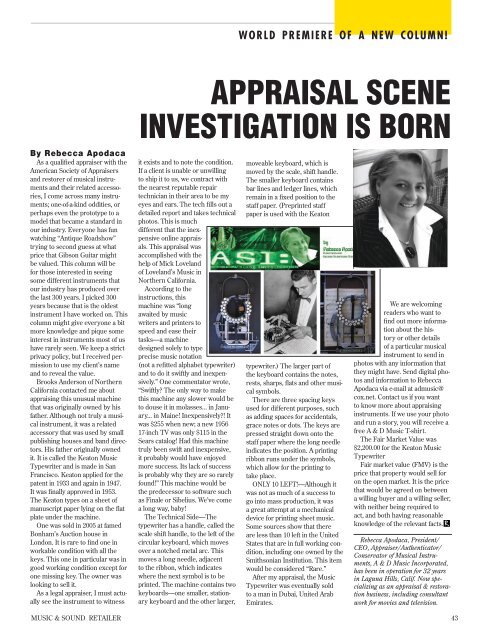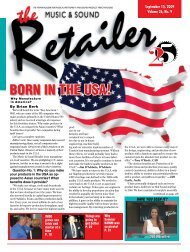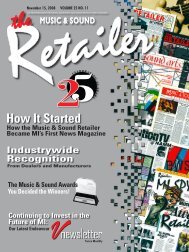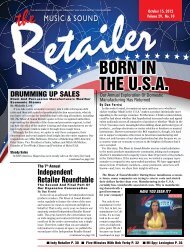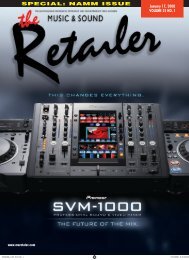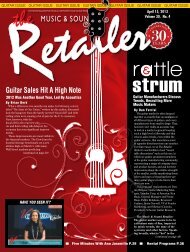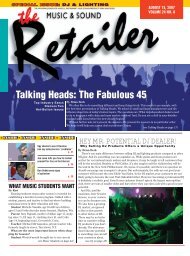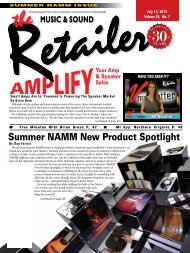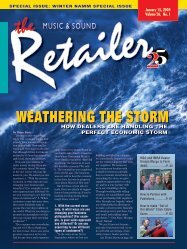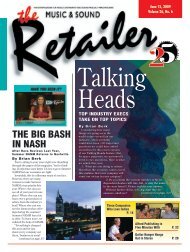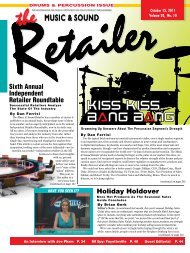laTeST - Music & Sound Retailer
laTeST - Music & Sound Retailer
laTeST - Music & Sound Retailer
You also want an ePaper? Increase the reach of your titles
YUMPU automatically turns print PDFs into web optimized ePapers that Google loves.
World Premiere of a New Column!<br />
Appraisal Scene<br />
INVESTIGATION is Born<br />
By Rebecca Apodaca<br />
As a qualified appraiser with the<br />
American Society of Appraisers<br />
and restorer of musical instruments<br />
and their related accessories,<br />
I come across many instruments;<br />
one-of-a-kind oddities, or<br />
perhaps even the prototype to a<br />
model that became a standard in<br />
our industry. Everyone has fun<br />
watching “Antique Roadshow”<br />
trying to second guess at what<br />
price that Gibson Guitar might<br />
be valued. This column will be<br />
for those interested in seeing<br />
some different instruments that<br />
our industry has produced over<br />
the last 300 years. I picked 300<br />
years because that is the oldest<br />
instrument I have worked on. This<br />
column might give everyone a bit<br />
more knowledge and pique some<br />
interest in instruments most of us<br />
have rarely seen. We keep a strict<br />
privacy policy, but I received permission<br />
to use my client’s name<br />
and to reveal the value.<br />
Brooks Anderson of Northern<br />
California contacted me about<br />
appraising this unusual machine<br />
that was originally owned by his<br />
father. Although not truly a musical<br />
instrument, it was a related<br />
accessory that was used by small<br />
publishing houses and band directors.<br />
His father originally owned<br />
it. It is called the Keaton <strong>Music</strong><br />
Typewriter and is made in San<br />
Francisco. Keaton applied for the<br />
patent in 1933 and again in 1947.<br />
It was finally approved in 1953.<br />
The Keaton types on a sheet of<br />
manuscript paper lying on the flat<br />
plate under the machine.<br />
One was sold in 2005 at famed<br />
Bonham’s Auction house in<br />
London. It is rare to find one in<br />
workable condition with all the<br />
keys. This one in particular was in<br />
good working condition except for<br />
one missing key. The owner was<br />
looking to sell it.<br />
As a legal appraiser, I must actually<br />
see the instrument to witness<br />
it exists and to note the condition.<br />
If a client is unable or unwilling<br />
to ship it to us, we contract with<br />
the nearest reputable repair<br />
technician in their area to be my<br />
eyes and ears. The tech fills out a<br />
detailed report and takes technical<br />
photos. This is much<br />
different that the inexpensive<br />
online appraisals.<br />
This appraisal was<br />
accomplished with the<br />
help of Mick Loveland<br />
of Loveland’s <strong>Music</strong> in<br />
Northern California.<br />
According to the<br />
instructions, this<br />
machine was “long<br />
awaited by music<br />
writers and printers to<br />
speed and ease their<br />
tasks—a machine<br />
designed solely to type<br />
precise music notation<br />
(not a refitted alphabet typewriter)<br />
and to do it swiftly and inexpensively.”<br />
One commentator wrote,<br />
“Swiftly? The only way to make<br />
this machine any slower would be<br />
to douse it in molasses... in January...<br />
in Maine! Inexpensively?! It<br />
was $255 when new; a new 1956<br />
17-inch TV was only $115 in the<br />
Sears catalog! Had this machine<br />
truly been swift and inexpensive,<br />
it probably would have enjoyed<br />
more success. Its lack of success<br />
is probably why they are so rarely<br />
found!” This machine would be<br />
the predecessor to software such<br />
as Finale or Sibelius. We’ve come<br />
a long way, baby!<br />
The Technical Side—The<br />
typewriter has a handle, called the<br />
scale shift handle, to the left of the<br />
circular keyboard, which moves<br />
over a notched metal arc. This<br />
moves a long needle, adjacent<br />
to the ribbon, which indicates<br />
where the next symbol is to be<br />
printed. The machine contains two<br />
keyboards—one smaller, stationary<br />
keyboard and the other larger,<br />
moveable keyboard, which is<br />
moved by the scale, shift handle.<br />
The smaller keyboard contains<br />
bar lines and ledger lines, which<br />
remain in a fixed position to the<br />
staff paper. (Preprinted staff<br />
paper is used with the Keaton<br />
typewriter.) The larger part of<br />
the keyboard contains the notes,<br />
rests, sharps, flats and other musical<br />
symbols.<br />
There are three spacing keys<br />
used for different purposes, such<br />
as adding spaces for accidentals,<br />
grace notes or dots. The keys are<br />
pressed straight down onto the<br />
staff paper where the long needle<br />
indicates the position. A printing<br />
ribbon runs under the symbols,<br />
which allow for the printing to<br />
take place.<br />
ONLY 10 LEFT!—Although it<br />
was not as much of a success to<br />
go into mass production, it was<br />
a great attempt at a mechanical<br />
device for printing sheet music.<br />
Some sources show that there<br />
are less than 10 left in the United<br />
States that are in full working condition,<br />
including one owned by the<br />
Smithsonian Institution. This item<br />
would be considered “Rare.”<br />
After my appraisal, the <strong>Music</strong><br />
Typewriter was eventually sold<br />
to a man in Dubai, United Arab<br />
Emirates.<br />
We are welcoming<br />
readers who want to<br />
find out more information<br />
about the history<br />
or other details<br />
of a particular musical<br />
instrument to send in<br />
photos with any information that<br />
they might have. Send digital photos<br />
and information to Rebecca<br />
Apodaca via e-mail at admusic@<br />
cox.net. Contact us if you want<br />
to know more about appraising<br />
instruments. If we use your photo<br />
and run a story, you will receive a<br />
free A & D <strong>Music</strong> T-shirt.<br />
The Fair Market Value was<br />
$2,200.00 for the Keaton <strong>Music</strong><br />
Typewriter<br />
Fair market value (FMV) is the<br />
price that property would sell for<br />
on the open market. It is the price<br />
that would be agreed on between<br />
a willing buyer and a willing seller,<br />
with neither being required to<br />
act, and both having reasonable<br />
knowledge of the relevant facts.<br />
Rebecca Apodaca, President/<br />
CEO, Appraiser/Authenticator/<br />
Conservator of <strong>Music</strong>al Instruments,<br />
A & D <strong>Music</strong> Incorporated,<br />
has been in operation for 32 years<br />
in Laguna Hills, Calif. Now specializing<br />
as an appraisal & restoration<br />
business, including consultant<br />
work for movies and television.<br />
<strong>Music</strong> & <strong>Sound</strong> <strong>Retailer</strong> 43


